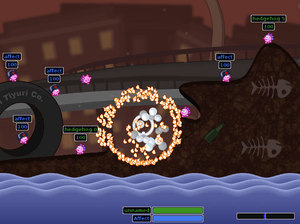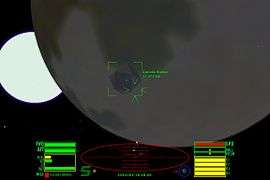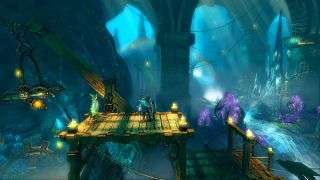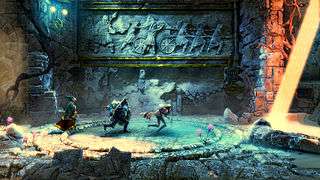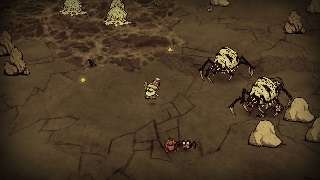Simple DirectMedia Layer
 SDL logo | |
| Original author(s) | Sam Lantinga |
|---|---|
| Developer(s) | SDL Community |
| Initial release | 1998 |
| Stable release | |
| Written in | C |
| Operating system |
Linux, Windows, OS X 10.4+, iOS 3.1.3+, Android 2.3.3+, FreeBSD 8.4+, Haiku Additionally before v2.0.0 (deprecated versions): AmigaOS, RISC OS[3] |
| Type | API |
| License |
zlib License Before 2.0.0: GNU LGPL[4] |
| Website |
www |
Simple DirectMedia Layer (SDL) is a cross-platform software development library designed to provide a hardware abstraction layer to computer multimedia hardware components. Software developers can use it to write high-performance computer games and other multimedia applications that can run on many operating systems such as Android, iOS, Linux, Mac OS X and Windows.[3]
SDL manages video, audio, input devices, CD-ROM, threads, shared object loading, networking and timers.[5] For 3D graphics it can handle an OpenGL or Direct3D context.
The library is internally written in C and, depending on the target platform, C++ or Objective-C, and provides the application programming interface in C, with bindings to other languages available.[6] It is free and open-source software subject to the requirements of the zlib License since version 2.0 and with prior versions subject to the GNU Lesser General Public License.[4] Under the zlib License, SDL 2.0 is freely available for static linking in closed-source projects, unlike SDL 1.2.[7]
SDL is extensively used in the industry in both large and small projects. Over 700 games, 180 applications, and 120 demos have also been posted on the library website.
A common misconception is that SDL is a game engine, but this is not true. However, the library is well-suited for building an engine on top of it.
History
Sam Lantinga created the library, first releasing it in early 1998, while working for Loki Software. He got the idea while porting a Windows application to Macintosh. He then used SDL to port Doom to BeOS (see Doom source ports). Several other free libraries were developed to work alongside SDL, such as SMPEG and OpenAL. He also founded Galaxy Gameworks in 2008 to help commercially support SDL, although the company plans are currently on hold due to time constraints.[8] Soon after putting Galaxy Gameworks on hold, Lantinga announced that SDL 1.3 (which would then later become SDL 2.0) would be licensed under the zlib License.[9] Lantinga announced SDL 2.0 on 14 July 2012, at the same time announcing that he was joining Valve Corporation, the first version of which was announced the same day he joined the company.[10] Lantinga announced the stable release of SDL 2.0.0 on 13 August 2013.[11]
SDL 2.0 is a major update to the SDL 1.2 codebase with a different, not backwards-compatible[12] API. It replaces several parts of the 1.2 API with more general support for multiple input and output options.
Some feature additions include multiple window support, hardware-accelerated 2D graphics, and better Unicode support.[13]
Support for Mir and Wayland was added in SDL 2.0.2[14] and enabled by default in SDL 2.0.4.[15]
Better support for Android in forthcoming 2.0.4.[16]
Software architecture
SDL is a wrapper around the operating-system-specific functions that the game needs to access. The only purpose of SDL is to provide a common framework for accessing these functions for multiple operating systems (cross-platform).[17] SDL provides support for 2D pixel operations, sound, file access, event handling, timing and threading. It is often used to complement OpenGL by setting up the graphical output and providing mouse and keyboard input, since OpenGL comprises only rendering.
A game using the Simple DirectMedia Layer will not automatically run on every operating system, further adaptations must be applied. These are reduced to the minimum, since SDL also contains a few abstraction APIs for frequent functions offered by an operating system.
The syntax of SDL is function-based: all operations done in SDL are done by passing parameters to subroutines (functions). Special structures are also used to store the specific information SDL needs to handle. There are a few different subsystems SDL categorizes its functions under.
SDL can be used instead of XInput and XAudio2.
Subsystems
SDL is divided into several subsystems:[18]
- Basics
- Initialization and Shutdown, Configuration Variables, Error Handling, Log Handling
- Video
- Display and Window Management, surface functions, rendering acceleration, etc.
- Input Events
- Event handling, Support for Keyboard, Mouse, Joystick and Game controller
- Force Feedback
- SDL_haptic.h implements support for "Force Feedback"
- Audio
- SDL_audio.h implements Audio Device Management, Playing and Recording
- Threads
- multi-threading: Thread Management, Thread Synchronization Primitives, Atomic Operations
- Timers
- Timer Support
- File Abstraction
- Filesystem Paths, File I/O Abstraction
- Shared Object Support
- Shared Object Loading and Function Lookup
- Platform and CPU Information
- Platform Detection, CPU Feature Detection, Byte Order and Byte Swapping, Bit Manipulation
- Power Management
- Power Management Status
- Additional
- Platform-specific functionality
Besides this basic, low-level support, there also are a few separate official libraries that provide some more functions. These comprise the "standard library", and are provided on the official website and included in the official documentation:
- SDL_image — support for multiple image formats[19]
- SDL_mixer — complex audio functions, mainly for sound mixing[20]
- SDL_net — networking support[21]
- SDL_ttf — TrueType font rendering support[22]
- SDL_rtf — simple Rich Text Format rendering[23]
Other, non-standard libraries also exist. For example: SDL_Collide on Sourceforge created by Amir Taaki.
Language bindings
The SDL 2.0 library has language bindings for C, C++, Pascal,[6] Perl (via sdl.perl.org),[6] Python (via PySDL2.0),[6] C#,[6] Lua,[6] OCaml,[6] Rust, Nim, Vala, Genie, and Go.[6]
Supported back-ends
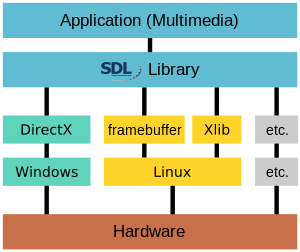
Because of the way SDL is designed, much of its source code is split into separate modules for each operating system, to make calls to the underlying system. When SDL is compiled, the appropriate modules are selected for the target system. Following back-ends are available:[3]
- GDI back-end for Microsoft Windows.
- DirectX back-end; but SDL 1.2 requires DirectX 7 by default. Sam Lantinga has stated that he plans to use DirectX 8 in future SDL releases.[24]
- Quartz back-end for macOS.
- Xlib back-end for X11-based windowing system on various operating systems.[25]
- OpenGL contexts on various platforms.[26]
- EGL back-end when used in conjunction with Wayland-based windowing system.,[27] Raspberry Pi[28] and other systems.
- sceGu back-end, a Sony OpenGL-like backend native to the PSP.
SDL 1.2 has support for RISC OS (dropped in 2.0).
An unofficial Sixel back-end is available for SDL 1.2.[29]
Reception and adoption
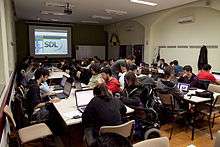
Over the years SDL was used for many commercial and non-commercial video game projects, for instance MobyGames listed 120 games using SDL in 2013[30] and the SDL website itself listed around 700 games in 2012.[31] Important commercial examples are Angry Birds[32] or Unreal Tournament, from the open source domain OpenTTD,[33] The Battle for Wesnoth[34] or Freeciv.[35]
The cross-platform game releases of the popular Humble Indie Bundles for Linux, Mac and Android are often SDL based.
SDL is also often used for later ports on new platforms with existing legacy code, for instance the PC game Homeworld was ported to the Pandora handheld[36] and Jagged Alliance 2 for Android[37] via SDL.
Also, several non video game software uses SDL, examples are the emulators DOSBox and VisualBoyAdvance.
There were several books written for the development with SDL (see further readings).
SDL is used in university courses teaching multimedia and computer science, for instance, in a workshop about game programming using libSDL at the University of Cadiz in 2010, or a Game Design discipline at UTFPR (Ponta Grossa campus) in 2015.
Video game examples using SDL
See also
- Allegro
- ClanLib
- Cross-platform support middleware
- DirectFB
- General Graphics Interface
- GLFW
- OpenML
- Pygame
- Ren'Py
- SFML
- SVGALib
References
- ↑ Simple DirectMedia Layer - SDL version 2.0.5 (stable). Libsdl.org (5 January 2001). Retrieved on 2016-10-20.
- ↑ Index of /release. Libsdl.org (17 August 2013). Retrieved on 2016-10-20.
- 1 2 3 "a list of the platforms SDL supports". Libsdl.org. Archived from the original on 2016-04-01. Retrieved 9 April 2016.
- 1 2 "SDL license". Retrieved 3 March 2014.
- ↑ "SDL official website". Libsdl.org. Retrieved 19 March 2010.
- 1 2 3 4 5 6 7 8 "SDL Language Bindings". libsdl.org. Simple DirectMedia Layer. Retrieved 13 August 2014.
- ↑ "Licensing the Simple DirectMedia Layer library". Retrieved 30 January 2012.
- ↑ "Exploring the Galaxy". 6 April 2011. Retrieved 30 January 2012.
- ↑ SDL 1.3 to be zLib Licensed, SDL Mailing List, 7 April 2011
- ↑ "SDL 2.0 Is Coming Very Soon With New Features". Retrieved 17 August 2012.
- ↑ Announcing SDL 2.0.0, SDL Mailing List, 13 August 2013
- ↑ MigrationGuide - SDL Wiki'. Wiki.libsdl.org (21 November 2013). Retrieved on 2013-12-08.
- ↑ "SDL 1.3 Roadmap". 14 June 2011. Retrieved 25 July 2011.
- ↑ Sneddon, Joey-Elijah (5 February 2014). "Some of Linux’s Most Popular Games Will Run Natively On Mir". Retrieved 19 March 2014.
- ↑ Lantinga, Sam (2 January 2016). "SDL 2.0.4 Changelog". Retrieved 6 January 2016.
- ↑ https://wiki.libsdl.org/SDL_SysWMinfo
- ↑ "Introduction to SDL". Retrieved 3 March 2014.
- ↑ https://wiki.libsdl.org/APIByCategory
- ↑ "SDL_image 2.0". libsdl.org. Retrieved 19 July 2014.
- ↑ "SDL_mixer 2.0". libsdl.org. Retrieved 19 July 2014.
- ↑ "SDL_net 2.0". libsdl.org. Retrieved 19 July 2014.
- ↑ "SDL_ttf 2.0". libsdl.org. Retrieved 19 July 2014.
- ↑ "SDL_rtf 0.1". libsdl.org. Retrieved 19 July 2014.
- ↑ "SDL mailing list". Libsdl.org. Retrieved 23 March 2010.
- ↑ "SDL: README-platforms.txt@3e2f230a6d62". Hg.libsdl.org. libsdl.org. Archived from the original on 2013-12-15. Retrieved 2013-12-08.
- ↑ "Using OpenGL With SDL". Retrieved 2015-07-09.
- ↑ "SDL and Wayland".
- ↑ Larabel, Michael (30 September 2013). "Raspberry Pi Support Added To SDL2 Library".
- ↑ "SDL 1.2 Sixel". Retrieved 2016-04-09.
- ↑ "Middleware: SDL Group Description". MobyGames. 27 September 2013. Retrieved 18 May 2012.
Games that use the very portable Simple DirectMedia Layer.
- ↑ "Games". libsdl.org. 18 May 2012. Retrieved 18 May 2012.
- ↑ "SDL Testimonials". Galaxygameworks.com. Archived from the original on 16 July 2011. Retrieved 1 February 2012.
- ↑ "Development". OpenTTD. Retrieved 19 March 2010.
- ↑ "CompilingWesnoth". Wesnoth. 27 February 2010. Retrieved 19 March 2010.
- ↑ "SDLClient - Freeciv.org". Freeciv.wikia.com. Retrieved 19 March 2010.
- ↑ may88 (23 June 2011). "Game of the Week #3 – Homeworld SDL". pandorapress.net. Retrieved 8 May 2012.
[...] released port of HomeworldSDL. Forum member Edglex enables your Pandora to experience the excellent work done by the guys at HomeworldSDL.
- ↑ JA2 Stracciatella Feedback » Jagged Alliance 2 Android Stracciatella Port RC2 Release - please test on the Bear's Pit Forum, 3 October 2011
- ↑ "Coding - The Freeciv Wiki - Mods, coding, art, and more". Retrieved 9 March 2015.
- ↑ "Features · fifengine/fifengine Wiki · GitHub". Retrieved 9 March 2015.
- ↑ "FAQ Hedgewars". hedgewars.org. Retrieved 3 October 2014.
... SDL >= 1.2.5 ...
- ↑ "Development Details". scorched3d.co.uk. Retrieved 3 October 2014.
... Simple DirectMedia Layer - SDL for cross platform game windowing ...
- ↑ "Roadmap - Wesnoth". www.wesnoth.org. Retrieved 9 March 2015.
- ↑ "Secret Maryo Chronicles". sourceforge.net. Retrieved 3 October 2014.
... based on SDL ...
Further reading
- Alberto García Serrano: Programación de videojuegos en SDL, Ediversitas, ISBN 84-95836-08-4 (Spanish)
- Ernest Pazera: Focus On SDL, Muska & Lipman/Premier-Trade, ISBN 1-59200-030-4
- Ron Penton: Data Structures for Game Programmers, Muska & Lipman/Premier-Trade, ISBN 1-931841-94-2 (game programming examples with SDL)
- John R. Hall: Programming Linux Games, No Starch, ISBN 1-886411-49-2 (First SDL book, by Loki Games, archived online version: PDF at the Wayback Machine (archived 22 January 2003), LaTex sources at the Wayback Machine (archived 14 February 2003))
- SDL Game Development by Shaun Mitchell
- Game Development with SDL 2.0 on YouTube – video from 11 February 2014 by Ryan C. Gordon

